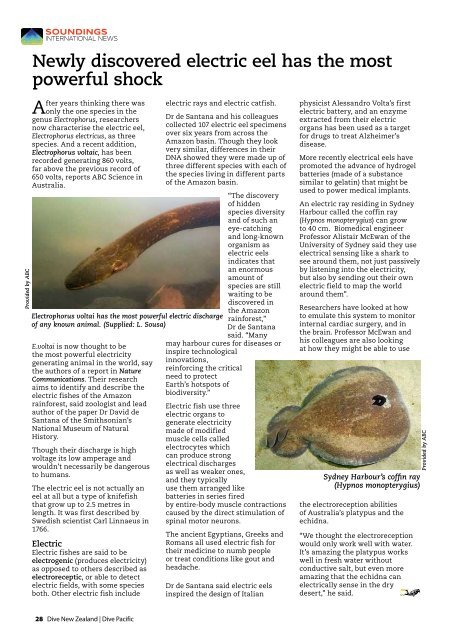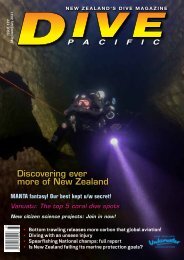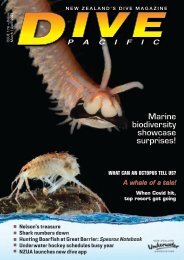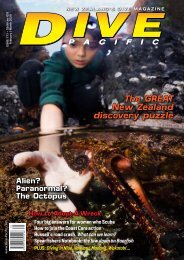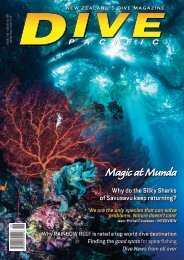Dive Pacific Iss 171 Oct- Nov 2019
New Zealand's dive magazine featuring in this issue: Shooting big sharks, up close; Spearfishing at night!; Remembering a great Kiwi dive pioneer, Wade Doak; Forgotten Vanuatu wreck's claim to fame; The invasive Lionfish - in depth, plus all our expert columnists
New Zealand's dive magazine featuring in this issue: Shooting big sharks, up close; Spearfishing at night!; Remembering a great Kiwi dive pioneer, Wade Doak; Forgotten Vanuatu wreck's claim to fame; The invasive Lionfish - in depth, plus all our expert columnists
You also want an ePaper? Increase the reach of your titles
YUMPU automatically turns print PDFs into web optimized ePapers that Google loves.
Provided by ABC<br />
SOUNDINGS<br />
INTERNATIONAL NEWS<br />
Newly discovered electric eel has the most<br />
powerful shock<br />
After years thinking there was<br />
only the one species in the<br />
genus Electrophorus, researchers<br />
now characterise the electric eel,<br />
Electrophorus electricus, as three<br />
species. And a recent addition,<br />
Electrophorus voltaic, has been<br />
recorded generating 860 volts,<br />
far above the previous record of<br />
650 volts, reports ABC Science in<br />
Australia.<br />
E.voltai is now thought to be<br />
the most powerful electricity<br />
generating animal in the world, say<br />
the authors of a report in Nature<br />
Communications. Their research<br />
aims to identify and describe the<br />
electric fishes of the Amazon<br />
rainforest, said zoologist and lead<br />
author of the paper Dr David de<br />
Santana of the Smithsonian’s<br />
National Museum of Natural<br />
History.<br />
Though their discharge is high<br />
voltage its low amperage and<br />
wouldn’t necessarily be dangerous<br />
to humans.<br />
The electric eel is not actually an<br />
eel at all but a type of knifefish<br />
that grow up to 2.5 metres in<br />
length. It was first described by<br />
Swedish scientist Carl Linnaeus in<br />
1766.<br />
Electric<br />
Electric fishes are said to be<br />
electrogenic (produces electricity)<br />
as opposed to others described as<br />
electroreceptic, or able to detect<br />
electric fields, with some species<br />
both. Other electric fish include<br />
electric rays and electric catfish.<br />
Electrophorus voltai has the most powerful electric discharge<br />
of any known animal. (Supplied: L. Sousa)<br />
Dr de Santana and his colleagues<br />
collected 107 electric eel specimens<br />
over six years from across the<br />
Amazon basin. Though they look<br />
very similar, differences in their<br />
DNA showed they were made up of<br />
three different species with each of<br />
the species living in different parts<br />
of the Amazon basin.<br />
“The discovery<br />
of hidden<br />
species diversity<br />
and of such an<br />
eye-catching<br />
and long-known<br />
organism as<br />
electric eels<br />
indicates that<br />
an enormous<br />
amount of<br />
species are still<br />
waiting to be<br />
discovered in<br />
the Amazon<br />
rainforest,”<br />
Dr de Santana<br />
said. “Many<br />
may harbour cures for diseases or<br />
inspire technological<br />
innovations,<br />
reinforcing the critical<br />
need to protect<br />
Earth’s hotspots of<br />
biodiversity.”<br />
Electric fish use three<br />
electric organs to<br />
generate electricity<br />
made of modified<br />
muscle cells called<br />
electrocytes which<br />
can produce strong<br />
electrical discharges<br />
as well as weaker ones,<br />
and they typically<br />
use them arranged like<br />
batteries in series fired<br />
by entire-body muscle contractions<br />
caused by the direct stimulation of<br />
spinal motor neurons.<br />
The ancient Egyptians, Greeks and<br />
Romans all used electric fish for<br />
their medicine to numb people<br />
or treat conditions like gout and<br />
headache.<br />
Dr de Santana said electric eels<br />
inspired the design of Italian<br />
physicist Alessandro Volta’s first<br />
electric battery, and an enzyme<br />
extracted from their electric<br />
organs has been used as a target<br />
for drugs to treat Alzheimer’s<br />
disease.<br />
More recently electrical eels have<br />
promoted the advance of hydrogel<br />
batteries (made of a substance<br />
similar to gelatin) that might be<br />
used to power medical implants.<br />
An electric ray residing in Sydney<br />
Harbour called the coffin ray<br />
(Hypnos monopterygius) can grow<br />
to 40 cm. Biomedical engineer<br />
Professor Alistair McEwan of the<br />
University of Sydney said they use<br />
electrical sensing like a shark to<br />
see around them, not just passively<br />
by listening into the electricity,<br />
but also by sending out their own<br />
electric field to map the world<br />
around them”.<br />
Researchers have looked at how<br />
to emulate this system to monitor<br />
internal cardiac surgery, and in<br />
the brain. Professor McEwan and<br />
his colleagues are also looking<br />
at how they might be able to use<br />
Sydney Harbour’s coffin ray<br />
(Hypnos monopterygius)<br />
the electroreception abilities<br />
of Australia’s platypus and the<br />
echidna.<br />
“We thought the electroreception<br />
would only work well with water.<br />
It’s amazing the platypus works<br />
well in fresh water without<br />
conductive salt, but even more<br />
amazing that the echidna can<br />
electrically sense in the dry<br />
desert,” he said.<br />
Provided by ABC<br />
28 <strong>Dive</strong> New Zealand | <strong>Dive</strong> <strong>Pacific</strong>


